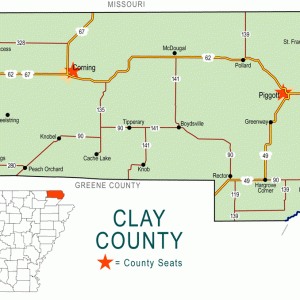calsfoundation@cals.org
Success (Clay County)
| Latitude and Longitude: | 36º27’16″N 090º43’17″W |
| Elevation: | 289 feet |
| Area: | 0.22 square miles (2020 Census) |
| Population: | 98 (2020 Census) |
| Incorporation Date: | December 18, 1903 |
Historical Population as per the U.S. Census:
|
1810 |
1820 |
1830 |
1840 |
1850 |
1860 |
1870 |
1880 |
1890 |
1900 |
|
– |
– |
– |
– |
– |
– |
– |
– |
– |
– |
|
1910 |
1920 |
1930 |
1940 |
1950 |
1960 |
1970 |
1980 |
1990 |
2000 |
|
379 |
436 |
308 |
281 |
311 |
226 |
201 |
223 |
170 |
180 |
|
2010 |
2020 |
|
|
|
|
|
|
|
|
|
149 |
98 |
|
|
|
|
|
|
|
|
Located at the intersection of State Highways 211 and 328 in the northwestern corner of Clay County, about three miles south of the Arkansas-Missouri state line, Success has its origins as a timber town near the railroad.
Settlers came slowly to northeastern Arkansas, both before and after Clay County was established in 1873 from parts of Randolph and Greene counties. The first settlers in the area that would become Success were associated first with the Heckt community that became Corning (Clay County) and then with the Bridgeport settlement that became Datto (Clay County). All this changed with the construction of the St. Louis, Iron Mountain and Southern Railway (later acquired by the Missouri Pacific Railroad) through Clay County. With modern transportation, the timber industry flourished in western Clay County, and the name Success was given to a post office that was established in the growing settlement in 1895. Rural schools were established in the area; they eventually became part of the Corning school system.
The town was incorporated in December 1903 and continued to grow. In addition to the sawmill, Success had two banks, three doctors, two cotton gins, a stave mill, and several retail businesses. Doctor Martin Waddle built a two-story frame house in 1909 where he lived until he went to serve in World War I, after which he and his family relocated to Missouri. Hardware and retail merchant John W. Baynham built a similar house in 1911. Both houses are now on the National Register of Historic Places. As the timber was cleared, land was converted to cotton fields and other agricultural pursuits. By 1920, the town had a population of 436 and was still noted to have a bank, a sawmill, and general stores.
The timber industry diminished in importance, and agricultural pursuits and banking also suffered during the Great Depression. After World War II, agriculture became increasingly mechanized. This contributed to a steady decline of population in Success, as in many similar towns throughout Arkansas. By 2010, the population of the town had fallen to 149 residents. As of 2010, Success still has a post office, a grain elevator, and a Baptist church. The most prominent resident of the town is Joe Jett, a commissioner of the Arkansas Department of Aeronautics and proprietor of Jett Aviation LLC.
For additional information:
“Baynham House” and “Waddle House.” National Register of Historic Places nomination forms. On file at Arkansas Historic Preservation Program, Little Rock, Arkansas.
Herndon, Dallas Tabor. Annals of Arkansas. Vol. 4. Hopkinsville, KY: Historical Record Association, 1947.
Steven Teske
CALS Encyclopedia of Arkansas
 Clay County Map
Clay County Map 




Comments
No comments on this entry yet.